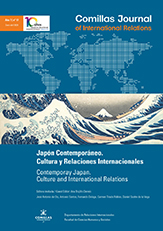La Bienal de Arte de Venecia y la participación japonesa en su última década (2011-2019)
Un ejemplo de interacción y diplomacia internacional
DOI:
https://doi.org/10.14422/cir.i17.y2020.006Palabras clave:
interacción, soft power, naturaleza, diplomacia, JapónResumen
El objetivo de este artículo es valorar el carácter de las exposiciones artísticas como modo destacado de relación internacional entre gentes de distintos países. Centrarnos en realizar un análisis de la participación japonesa en las últimas cinco Bienales de Arte de Venecia nos ayudará, a través de sus planteamientos, a hilvanar un discurso que tiene mucho que ver con el ejercicio del soft power, de ahí el interés en profundizar en los planteamientos teóricos de cada una de ellas. A través del análisis, se demuestra una actitud proactiva de Japón para promover a nivel global y por medio de su experiencia, una corresponsabilidad en el repensar nuestra actitud soberbia frente a la naturaleza. El arte tiene mucho que decir en el mundo de la diplomacia.
Descargas
Referencias
Artist interview. Chiharu Shiota, about The Key in the Hand. Japan Pavillion at the 56th International
Art Exhibition la Biennale di Venezia (s.f.). Recuperado de https://2015.veneziabiennale-japanpavilion.jp/en/project/
Bianchini, R. (13 de mayo de 2019). “Cosmo-Eggs” – The Japan Pavilion at the 58th Venice Art Biennale 2019. Innexhibit. Recuperado de https://www.inexhibit.com/case-studies/cosmo-eggs-the-japan-pavilion-at-the-58th-venice-art-biennale-2019/
BiennaleChannel. (1 de junio de 2003). Intervista con Koki Tanaka alla 55. Esposizione Internazionale d’Arte (partecipazione nazionale del Giappone) [archivo de video]. Recuperado de https://www.youtube.com/watch?v=gcb7wNP383k
Biennale di Venezia (1996). La Biennale di Venezia: Le esposizioni internazionali d’arte 1895-1995: artisti, mostre, partecipazioni nazionali, premi. Venezia: La Biennale di Venezia Electa.
Bissiablu. (26 de septiembre de 2014). Tabaimo: teleco-soup - BIENNALE ARTE VENEZIA 2011 - padiglione Giapponese [archivo de video]. Recuperado de https://www.youtube.com/watch?v=t-Elfifvgho
Chipperfield, D. (2012). Biennale Architettura 2012: Common Ground: 29.08-25.11 Venice. Venice: Random House Incorporated.
Construction of the Japanese Pavillion at the Venice Biennale (s.f.). Ishibashi Foundation. Japón. Recuperado de http://www.ishibashi-foundation.or.jp/english/founder/venice_biennale.html
Doeser J., y Nisbett, M. (2017). The art of soft power: A study of cultural diplomacy at the UN Office in Geneva. King´s College London & United Nations Geneva. Recuperado de: https://www.kcl.ac.uk/archive/cultural/documents/theartofsoftpower-v1-web.pdf
Galerie Templon. (12 de enero de 2016). Chiharu Shiota, The Key in the Hand, Biennale de Venise 2015 [archivo de video]. Recuperado de https://www.youtube.com/watch?v=u_M40SwNw0w
Gehman, C., y Reinke, S. (2005). The Sharpest Point: Animation at the End of Cinema. Richmond: YYZ Books.
Jahn, A. (2016). An interview with Chiharu Shiota. Berlin: Kerber Verlag.
Japan Pavilion at the 56th International Art Exhibition, the Venice Biennale in 2015: Message from the Artist (s.f). Japan Foundation. Recuperado de https://www.jpf.go.jp/e/project/culture/exhibit/international/venezia-biennale/art/56/key_submission.html
Koki Tanaka x Mika Kuraya. (2013). Preparations Underway for the Summer! Japan Pavilion at the 55th International Art Exhibition, the Venice Biennale Wochi Kochi Magazine. Recuperado de https://www.wochikochi.jp/english/topstory/2013/01/biennale-venezia-55.php
Leheny, D. (2014). From resistance to attractiveness: the politics of values and regionalism in East Asia. En Y. N. Soysal, Transnational Trajectories in East Asia: Nation, Citizenship, and Region. London: Routledge.
Mancaniello, A. (2015). Chiharu Shiota, a dimensión hanging in remembrance. Arte e Arti. Recuperado de http://www.artearti.net/magazine/articolo/chiharu-shiota-a-dimensionhanging-in-remembrance/
Minamishima, H. (2012). Venice Biennale Japan Pavilion: Recognizing the Significance of Architecture as a Blessing. Wochi Kochi Magazine. Recuperado de https://www.wochikochi.jp/english/special/2012/10/venicebiennalejapan.php
Nakano, H. (2015). Chiharu Shiota: The Key in the Hand. Japan Pavillion at the 56th International Art Exhibition la Biennale di Venezia. Recuperado de https://2015.veneziabiennalejapanpavilion.jp/en/project/
Nye J. (2005). Soft Power, The Means to Success in World Politics. New York: PublicAffairs.
Press Release: The Japan Pavilion Exhibition at the 58th International Exhibition- La Biennale di Venezia (2019). Motoyuki Shitamichi + Taro Yasuno + Toshiaki Ishikura + Fuminori Nousaku have been selected to represent Japan (19 de junio de 2018). Japan Foundation. Recuperado de https://www.jpf.go.jp/e/about/press/2018/dl/2018-008.pdf
Ringelberg, K. (2018). Tabaimo. Oxford University Press.
Rubio, C. y Tani, R. (trad.) (2008). Kokiji. Crónicas de Antiguos Hechos de Japón. Madrid: Trotta.
Sam Bourke. (29 de julio de 2014). 日本の通勤電車 Japanese Commuter Train. Tabaimo [archivo de video]. Recuperado de https://www.youtube.com/watch?v=g4RXCR5eo9w
Shiota Chiharu. https://www.chiharu-shiota.com/
Shiota, Ch. (2015). Chiharu Shiota: The Key in the Hand. Berlin: Distanz.
Shiota Ch. (2015b). Japan Pavilion at the 56th International Art Exhibition, the Venice Biennale in 2015: Message from the Artist. Japan Foundation. Recuperado de https://www.jpf.go.jp/e/project/culture/exhibit/international/venezia-biennale/art/56/key_submission.html
Shitamichi Motoyuki. Cossmo-Eggs. Venice Biennale 2019 Japan pavilion 2019. Recuperado de http://m-shitamichi.com/exts
Shitamichi, M., Yasuno T., Ishikura T., Nousaku F. y Hattori H. (2019). Cosmo-Eggs. Tokyo: LIXIL.
Tabaimo on Venice Biennale: A Complete Report (Part I) (1 de septiembre de 2011). Wochi Kochi Magazine. Recuperado de https://www.wochikochi.jp/english/topstory/2011/09/venezia-biennale01.php
Tabaimo on Venice Biennale: A Complete Report (Part II) (1 de septiembre de 2011b). Wochi Kochi Magazine. Recuperado de https://www.wochikochi.jp/english/topstory/2011/09/venezia-biennale02.php
Takahiro Iwasaki. Turned Upside Down, It´s a Forest. Japan Pavilion at the 57th International Art Exhibition – la Biennale di Venezia. Recuperado de https://2017.veneziabiennalejapanpavilion.jp/en/
Tanaka, K., Munder H., & Han, T-H. (2019). Koki Tanaka. Zurich: JRP Ringier Kunstverlag AG.
The Japan Foundation. Recuperado de https://www.jpf.go.jp/e/about/index.html
Thomson, L. (15 de junio de 2015). Takahiro Iwasaki in Conversation. Ocula Conversation. Recuperado de https://ocula.com/magazine/conversations/takahiro-iwasaki/
Washida, M. (2017). Itsukushima Shrine and the Atomic Bomb Dome: Communicating Traditional Eastern Values in Venice. Wochi Kochi Magazine. Recuperado de https://www.wochikochi.jp/english/special/2017/10/itsukushima-shrine-and-the-atomic-bomb-dome-communicating-traditional-eastern-values-in-venice.php
Washida, M. (2017b). Takahiro Iwasaki at the Japan Pavilion: Of the Venice Biennale 2017. Milano: Skira.
Yanagi Soetsu comes here, without invitation - Koki Tanaka and Hu Fang in conversation (21 de septiembre de 2013). Kadist. Programs Collection Artist. Recuperado de https://kadist.org/program/yanagi-soetsu-comes-here-without-invitation-koki-tanaka-and-hu-fang-inconversation/
Descargas
Publicado
Número
Sección
Licencia
Los autores de artículos aceptados en Comillas Journal of International Relations conservan los derechos de propiedad intelectual sobre sus trabajos y otorgan a la revista los permisos de distribución y comunicación pública de los mismos, consintiendo que se publiquen bajo una licencia Creative Commons Atribución-NoComercial-SinDerivadas 4.0 Internacional. Se recomienda a los autores publicar su trabajo en Internet (por ejemplo en páginas institucionales o personales, repositorios, etc.) respetando las condiciones de esta licencia y citando debidamente la fuente original.













